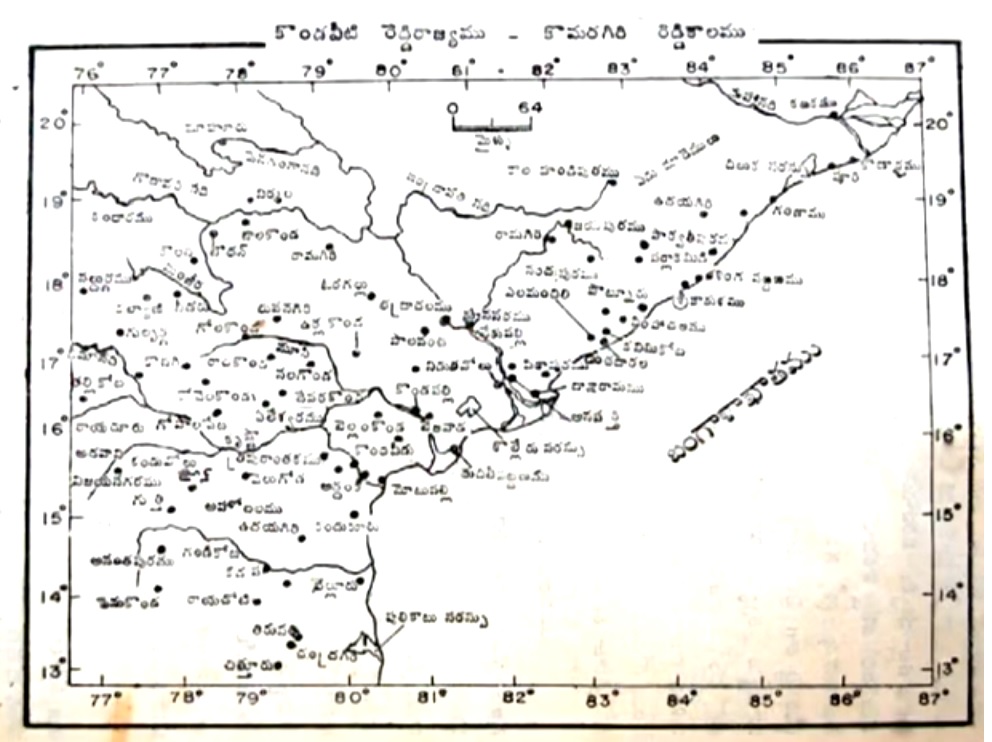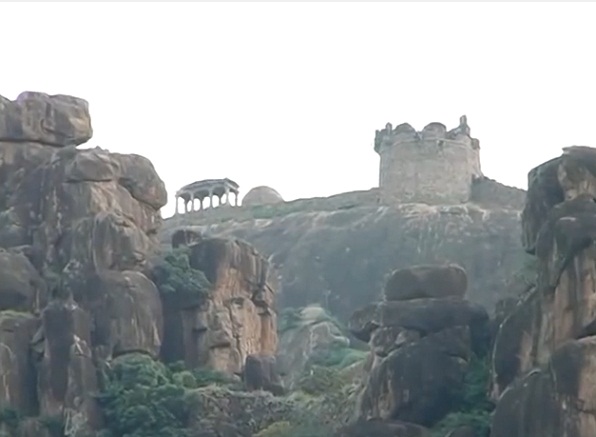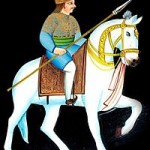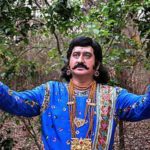Those of you following us on twitter would have read our tweets on the Reddi Kings (storified for you here: Reddi Rajyam — Romantic Age of Andhra). This dynasty of rulers has a special place in the heart of Telugus. It was an era of romance, of great kings feuding, and chivalrous knights clashing, and it truly was an age of romantic poetry.
It was the mighty personality of Prolaya Vema Reddi who made this all possible. The title he took is emblematic of the spirit of Andhra he embodied ‘Mlechchhabdi Kumbhodbhava’ (Agastya to the Ocean of the Mlechchhas)“. He proved a successful successor to the Legacy of Saka-pallava-yavana-nisudhana.
Gautamiputra Satakarni of the Satavahana dynasty would similarly defend Andhra when faced with foreign invasions. Both the rulers of Amaravati and Addanki respectively would preside over a cultural flowering as well. While the Satavahanas would become veritable all-India emperors, the Reddi kings of the coast are notable for a different type of emperor they produced—a Kavi Sarvabhauma named Srinatha. And it all began with Prolaya Vema Reddi, one of our Great Andhra Personalities.
Background
Malampalli Somesekhara Sarma garu provides the following etymology for the Reddis. Noting their erstwhile connection with the Rashtrakutas or Rattas, he writes that the term Desati was a form of Desarattodi. This word is found in the copper grants of the Eastern Chalukya king Ammaraja Vijayaditya VI. Rattodi then became Rattadi, Ratti and Raddi. Desarattodi in turn transformed to Desarattadi, Desaratti and Desatti. [3, 56] Reddi nobles are considered to have come from towns like Simhavikramapuri (Nellore), Duvooru, and Gandavaram.
During the rule of the Kakatiya dynasty, Reddis became administrators and even mahasamantas, governing tracts of the Telugu desa. The Kondaveeti Dandakavile and the kaifiyat intimate that Donti was the family name of this particular clan of Reddis, or atleast one of its affiliate branches. They are said to have found a treasure and then migrated to Hanumakonda, the preceding capital of the Kakatiyas.[3, 53] Elsewhere, specifically in the Kasikhandam and Bhimesvara Puranam of Srinatha, we find the surname Desati attached to them. Nevertheless, this family became influential in the united Andhra desa.
One of the 77 Nayaks of Mahamandalesvara Prataparudra Kakatiya II was Prolaya Reddi (his wife was Annemamba). Prolaya’s father Vema was the Vamsakarta and his grandfather was Kaamabhupa. [3, 48 ] Members of this clan were also noted for their service under the Telugu Chodas of Nellore. This connection would become important when the dynasty rose to power. But it is his son who would become the most famous of the dynasty: Prolaya Vema Reddi, whose leadership ran from 1325-1353.
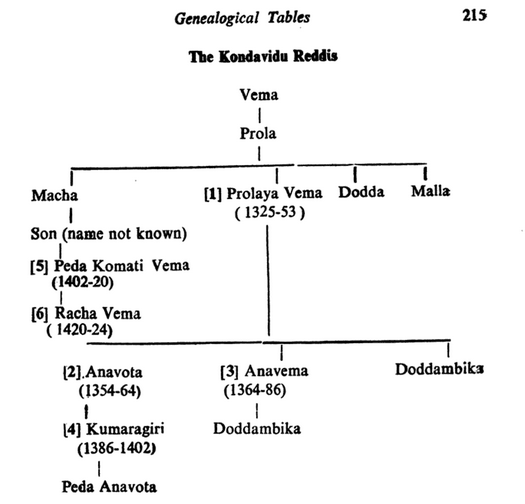
It came into existence as the custodian of Hindu dharma and culture, and to revive the old Vedic traditions and ritual which suffered a death blow and became almost extinct under an alien rule. [3]
Prolaya Vema was the son of Prolaya Reddi, and was among the 75 subordinates of Musunuri Prola and Kapaneedu (Krishna), who successively served as Overlords of the Andhra Nayak Confederacy. Prolaya Vema as the middle of five brothers. His younger brother Malla became ruler of the subordinate branch at Kandakooru. This branch would successfully face off against Alauddin Bahman Shah, who invaded shortly after his reign began. [3, 77]
Malla Reddi, the commander of the Reddi forces drove them away after inflicting a severe defeat on the Bahmani Sultan, Ala-ud-din, and protected the Reddi kingdom. [3, 78]
Malla would go on to conquer the great Kakatiya Port of Motupalli. Prolaya Vema would strengthen his position by giving his daughter in marriage to Choda Bhima (son of Bhaktiraja.”The Reddis regarded themselves as masters of the south-eastern portion of the Kakatiya dominion extending from Srisailam in the Nandikotkur taluk of Kurnool district to the east coast.” [3, 78]This dynasty controlled 84 forts, including the legendary Kondaveedu, along with Vinukonda, Kondapalli, Bellamkonda, and Dharanikota. They also had a famous rivalry with the Recharlas of Rachakonda, traitors of Andhra who betrayed the Musunuri Nayaks and allied with the Bahmanis. While some claim the fall of Krishna Nayak’s prestige led to the Nayaks of Korukonda and the Reddis to declare sovereignty, records from the Reddi kingdom itself tell a different story.
The Kaluvaceru grant of Anitalli, dated Saka 1345 (1423 A.D.) gives a different account of Vema’s assumption of independent rule. It says that Vema, originally one of the seventy five subordinate chiefs of Kapaya Nayaka, began to rule the territory independently only after the death of his overlord. [3, 80]
In any event, the leader of the Panta Reddi clan would thus go on to establish a powerful kingdom that would culturally revive the Andhras of the Coast, and protect them from Turk depredations for a century.
Achievements

A staunch Hindu devoted to Dharma, Prolaya Vema patronised the Hindu religion as well as the Telugu language. After liberating coastal Andhra from the criminal regime of the Tughluq Turks, he restored Agraharas to Brahmanas and re-consecrated Temples desecrated by the Delhi sultans. Prolaya’s patronage extended to the famous Errana (Erra Pragada) who finally completed that masterpiece of Telugu literature, Andhra Mahabharatamu.
A dutiful and considerate ruler, Prolaya was also known for planting trees on the edges of roads and digging wells for the benefit of journeymen.
- Revolted against Delhi Turks. Became one of the Commanders who liberated Andhra
- Founded the Reddi Kingdom
- Built or renovated 84 forts according to tradition
- Constructed the great Fortress of Kondaveedu, which would later serve as capital
- Gave 44 Agraharas to Brahmins who had been dispossessed by Tughluq Turks
- Built temples and constructed tanks and replenished treasuries
- Set up feeding houses and drinking water sheds.
- He also planted numerous flower and fruit gardens for the public.
Legacy
The Panta clan of Reddis would set up and rule three different kingdoms at Kondaveedu, Rajamahendravaram, and Kandookuru. There were three main families, with Prolaya Vema’s being the senior one, but Allaya Reddi’s (Donti family) and Kataya Vema Reddi‘s also being influential. These would all inter-marry, along with the Suryavamsa Kshatriya family of Choda Bhaktiraja (relations of the once Telugu Choda Kings of Nellore).
Vema ruled his new principality very ably and justly. He strove hard to relieve the brahman and the peasant from their miserable plight and to give them protection and every facility to follow their own pursuits and professions, unmolested by foreign aggression and internal disorders. He thereby rightly earned the title dharmapratishtanaguru, the revered that established the dharma. [3, 87]
He generously spent his resources to give patronage to brahmanas, as they were repositories of knowledge and custodians of Vedic rites and rituals. He is said to have given as many as 44 agraharas during his reign. Such a notable yajamana was he that he was called anavarata-purohita-krta-somapana, one who cause the purohits to take the Soma juice incessantly. [3, 88]
Interestingly, neither he nor his overlord Musunuri Kapaneedu took the traditional Royal title Mahamandalesvara, as the Kakatiyas Kings did, and as the Vijayanagara Emperors did from the beginning. Prolaya Vema Reddi contented himself with the title Srimathu.
Prolaya Vema I had three sons, Anavota I, Anamaacha, and Anavema and two daughters. One daughter Doddamba, who married Kata Reddi II, and the other daughter married Choda Bhima, who was the son of Bhaktiraja. Anamaacha appears to have died young.
The celebrated poet Erra Pragada himself sketches an image of his patron, Prolaya Vema. The Court Poet of the first Reddi King wrote in his Harivamsam that the ruler was an expert bow-man and a great warrior. Prolaya Vema was humble and god-fearing, and a disciple of Ghodeyaraya Gangeyadeva.
Ghoderaya Gangayadeva
“Members of the Ghoderaya family exercised over the Reddi kings much influence as their gurus throughout their political career.” [3, 65]
As spiritual guides and preceptors, the Ghoderayas would have encouraged the commitment of the Reddi kings to traditional Hindu Dharma, and to the restoration of the ancient Vedic rites and rituals. Gangayadeva was considered an honest and able administrator, who himself undertook many charitable works. Nevertheless, Prolaya Vema Reddi was very much his own man.
Kondaveeti Kota Srimathu
Perhaps nothing embodied the contributions of Prolaya Vema Reddi more than the great fortress of Kondaveedu. Though Addanki was the first capital, Prolaya Vema showed great strategic foresight in recognising the need for strong fortifications from which to resist the murderous attacks of the cavalry archer Turks (Tughluq or Bahmani). Kondaveedu was the stone citadel that would be celebrated by later generations in both story and song. Truly, it was the home of the Kondaveeti Rajas.
Thus, his legacy extends from Addanki to Kondaveedu to Kandukooru to Rajamahendravaram. Coastal Andhra and even parts of Telangana and Rayalaseema saw the force of arms from this Reddi King and his successors. Some accounts assert he successfully campaigned as far as Odisha.
The valuable assistance rendered by his maternal uncles Potaya, Nagaya, and Chittaya, along with that of his brothers, showed the value of family and community unity in forging state unity. [3, 77] Each building block was a force-multiplier to the other (as Shivaji would later show in setting the stage for national unity).
Thus, the legacy of Prolaya Vema Reddi is one that extends from the great Andhra Liberation War, to the establishment of the 100 year Reddi Kingdom of Coastal Andhra, to the Cultural Revival of Andhra. Truly a great personality and a great king.
References:
- P. Ragunadha Rao. History and Culture of Andhra Pradesh.Sterling: Delhi.18
- Prasad, Durga. History of the Andhras. Don Bosco Press: Guntur. 1988
- Malampalli, Somasekhara Sarma. History of the Reddi Kingdoms.Delhi:Facsimile Publ. 2015
- Chitnis, Krishnaji Nageshrao. Medieval Indian History. New Delhi: Atlantic Publ. p.215


